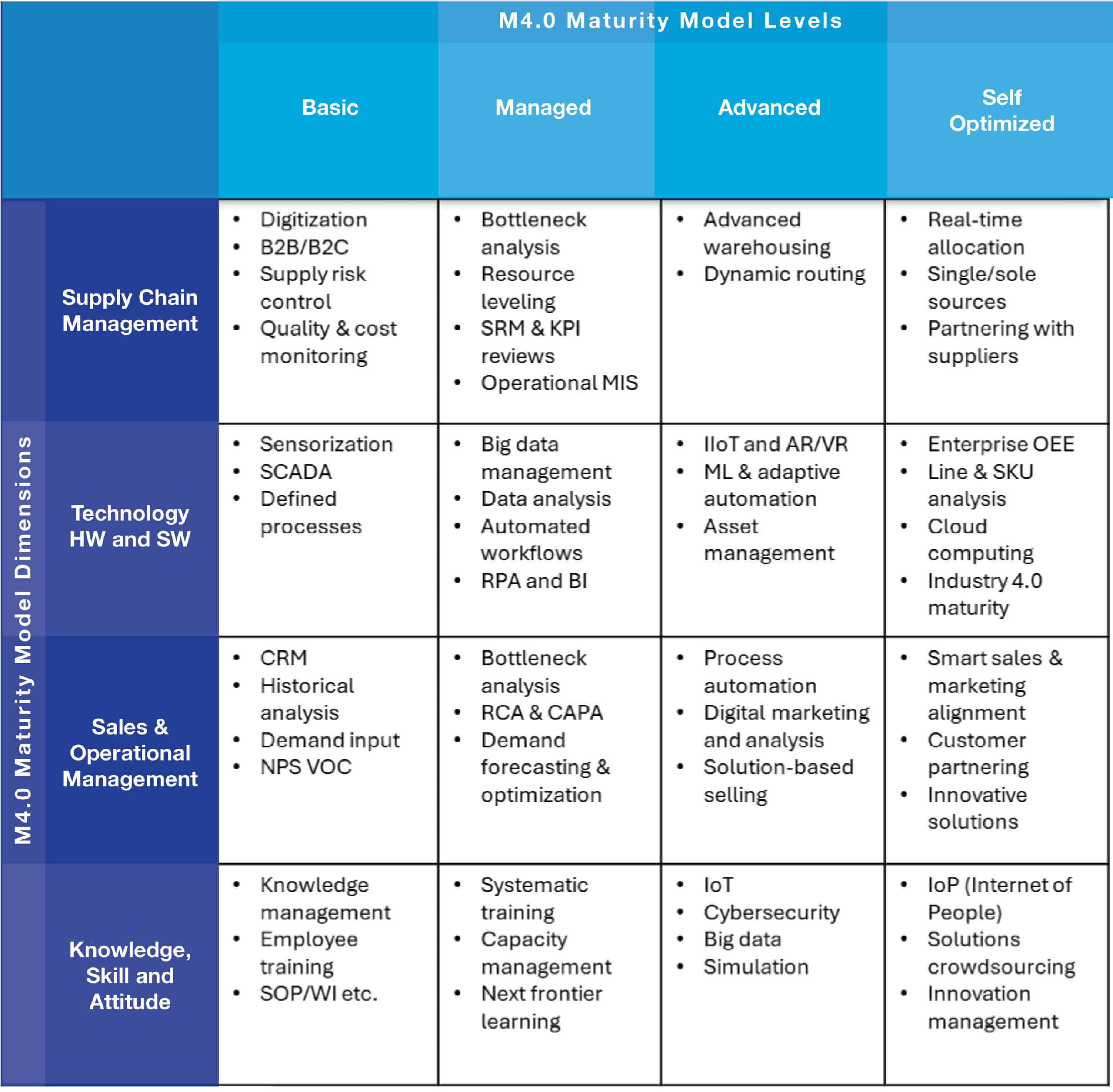Unlocking Manufacturing Excellence with the M4.0 Maturity Model

The M4.0 maturity model offers manufacturers a thorough and effective way to evaluate current and desired maturity levels.

TAKEAWAYS:
● The M4.0 maturity model assesses readiness and capabilities across four dimensions: supply chain management, technology, sales and operational management, and knowledge, skills, and attitude.
● The M4.0 maturity model offers a structured approach to evaluate the current state, set realistic goals, and remain on a path of continuous improvement.
● By using the model, companies can uncover valuable information about their current and desired maturity levels, including gaps and areas for growth.
Navigating the complexities of new technology adoption and process improvement, many organizations (particularly small and medium-sized enterprises) are often hindered by the diverse maturity levels across key organizational dimensions. Challenges range from bridging the gap between strategic vision and execution due to skill and cultural gaps, to aligning advanced technology investments with the right organizational structures. The Manufacturing 4.0 (M4.0) maturity model emerges as a pivotal framework, offering companies a structured approach to evaluate their current situation, set realistic goals, and remain on a path of continuous improvement across critical areas. In this article, we explore the strategic impact of the M4.0 maturity model on the journey to manufacturing excellence.
What Is the M4.0 Maturity Model?
The M4.0 maturity model serves as a framework designed to assess the readiness and capabilities of organizations across four main dimensions:
1. Supply Chain Management
2. Technology (Hardware and Software)
3. Sales and Operational Management
4. Knowledge, Skill, and Attitude
The model also lays out four maturity levels within the M4.0 spectrum, from basic awareness to the self-optimization of practices throughout the value chain. It empowers organizations to take meaningful steps towards enhancing their operational performance and competitive stance within their industry.
Why Implement the Model?
The M4.0 maturity model offers a nuanced way to evaluate the health and potential of your business, or specific projects, moving beyond mere goal achievement to assess their capacity, respectively, for continuous improvement. This model excels where traditional models may fall short, as it can interpret qualitative data to determine a company’s long-term trajectory and performance. By defining different levels of effectiveness, it can identify the current position of any person, team, project, or company within the model.
“It [the M4.0 maturity model] empowers organizations to take meaningful steps towards enhancing their operational performance and competitive stance within their industry.””
Implementing the M4.0 maturity model can reveal valuable information about a company’s performance and potential, highlighting areas for learning and growth by bridging the gap between the current and desired maturity levels. Let’s explore the model’s structure, starting with its levels and then its dimensions.
M4.0 maturity model levels
- Basic: Characterized by a reactive approach, the organization has minimal visibility and control over its processes; it relies on manual and compartmentalized systems, which limits its flexibility to changes and opportunities.
- Managed: The organization adheres to some established standards and best practices, using basic tools and technologies for process oversight and enhancement. It can navigate some changes but struggles with cross-functional coordination and collaboration.
- Advanced: With the adoption of tools like cloud computing, the Internet of Things (IoT), artificial intelligence (AI), and big data analytics, the organization has high visibility and control, allowing it to proactively optimize operations. At this level, the organization demonstrates a culture of innovation and continuous improvement across functions and partners.
- Self-optimized: The organization is a leader in its industry, with significant competitive advantages in quality, efficiency, agility, and customer satisfaction. It leverages cutting-edge tech, such as digital twins, blockchain, and 5G, to create smart and connected offerings. It’s also highly adaptable and resilient, excelling in new market ventures and opportunity capitalization. Organizations at this level take their culture of innovation and continuous improvement to the next level, setting a standard for a culture of excellence and empowerment across functions and partners.
M4.0 maturity model dimensions
- Supply Chain Management: Measures the effectiveness of managing the supply chain from sourcing to delivery, aiming to meet customer needs proficiently.
- Technology: Assesses the integration of relevant technologies to boost operational efficiency and product/service quality.
- Sales Operation Strategy: Evaluates how well the sales strategy aligns with business objectives and customer segmentation, focusing on resource and process optimization.
- Knowledge, Skill, and Attitude (People and Culture): Gauges the development and engagement of human capital, both internally and externally, in alignment with the organization’s vision, mission, and values.
We present the full M4.0 maturity model matrix (Figure 1).
Figure 1: The Full M4.0 Maturity Model matrix

M4.0 Maturity Model FAQs
Q: Is striving to reach the “Self-optimized” level necessary for all companies using the maturity model?
A: While not every company may need to reach the “Self-optimized” level across all dimensions, focusing on key areas where M4.0 technologies can drive significant competitive advantage remains crucial. The implementation of IoT solutions, for instance, allows companies to visualize overall equipment effectiveness (OEE) metrics through easy-to-use dashboards, gain real-time insights into production, and optimize processes. Activities like this can significantly enhance manufacturing efficiency and sustainability, despite being much closer to the “Advanced” level than they are to the “Self-optimized” level.
Q: How does this model, which may seem theoretical, get put into practice?
A: The model primarily serves as a benchmarking tool, allowing companies to compare technology domains across different areas and maturity levels with their current operational state and future goals. This comparison highlights gaps in digital capabilities, illuminating areas ripe for strategic improvement. The real shift from theory to practice occurs when companies begin the phases of adoption, after reaching a consensus on their focus areas and desired technologies. At this point, navigating this transformation involves working with the right partners, adapting management strategies, and ensuring technological integration that goes beyond mere adoption to fully embedding these advancements into the organizational fabric. For more on the practical application of the M4.0 maturity model, see our article “Four Steps to Scale M4.0 Adoption Organization-Wide.”
“Ultimately, it [the model] guides companies through incremental improvements, both in the short and long term, ensuring that enhancements contribute to a unified vision.”
Q: What is the role of plant managers within the model?
A: Plant managers play a crucial role in the digital transformation journey within manufacturing facilities. As digital technologies are increasingly adopted, plant managers emerge as essential leaders of this shift. Their responsibilities extend across several key areas: leading change, integrating data across systems, managing transitions smoothly, and supporting collaboration among teams. As adoption leaders, plant managers ensure their teams are aligned and equipped to excel as the manufacturing technology environment evolves.
Q: Which key performance indicators (KPIs) should a company track when applying the model?
A: Companies should monitor KPIs that align with the model’s four areas, ensuring a holistic view of progress and areas for continuous improvement:
- Supply Chain Management: Focus on KPIs like lead times, inventory turnover rates, supplier performance metrics, and logistics cost to gauge efficiency and responsiveness.
- Technology (Hardware and Software): Track system uptime, response times, frequency of software deployments, and rates of security incidents to evaluate the reliability and efficiency of technological infrastructure and workflows.
- Sales and Operational Management: Measure sales performance, customer satisfaction levels, order fulfillment speeds, and revenue growth to assess the effectiveness of sales strategies and operations.
- Knowledge, Skill, and Attitude: Mature organizations invest in continuous learning and empower employees to contribute effectively. Monitor employee training completion rates, progress in skill development, and employee engagement scores.
Q: How does the model, which categorizes maturity into separate areas and levels, promote organizational integration and visibility?
A: The model, while visually segmented, is designed to promote holistic organizational growth. Its structure allows companies to assess and advance each area systematically without losing sight of overall operational cohesion. By providing clear benchmarks for each area, at each area, at each maturity level, the model enables organizations to see how progress in one segment influences and is influenced by others, fostering end-to-end visibility and integration. Ultimately, it guides companies through incremental improvements, both in the short and long term, ensuring that enhancements contribute to a unified vision.
M4.0 Maturity Model in Action: A Case Study in the Cable Sector
We present a brief case study to demonstrate how the M4.0 Maturity Model works in action.
Challenge
Amidst significant SAP implementations across new plants, our client faced challenges in goal setting and project management due to uneven technology adoption. While advanced systems were deployed in some departments, other areas remained heavily reliant on manual processes, lacking real-time data and streamlined operations. This challenge, a common issue in Latin American markets, hindered operational efficiency and adaptability.
“By leveraging the M4.0 maturity model, companies can unlock manufacturing excellence, enhance operational performance, and secure a competitive advantage within their industry.”
Our Approach
We leveraged a proprietary solution accelerator to integrate IoT sensors with the client’s existing programmable logic controllers and SAP systems and funnel insights into powerful efficiency dashboards. While a more conventional approach would involve developing solutions on one of the main cloud platforms, this often leads to extended project timelines and complex integration processes. Given the client’s concurrent project engagements, they were particularly averse to the risks associated with extensive development and integration phases. By aligning our solution accelerator with the client’s current technological ecosystem, we accelerated adoption timelines while significantly reducing the likelihood of operational disruptions.
Impact
Integrating IoT with the client’s systems propelled them from a basic to an advanced level within the Technology dimension of the M4.0 maturity model in just a few months. This transformation not only showcases the potential for swift operational efficiency improvements using solution accelerators but also highlights the important balance between innovation and execution. By embedding advanced technology within existing infrastructures, this phased approach to adoption bypassed the need for extensive system overhauls.
M4.0 Is a Powerful Framework
The M4.0 maturity model emerges as a powerful framework for navigating the complexities of new technology adoption and process improvement in manufacturing. By offering a structured approach to assess readiness and capabilities across critical dimensions such as supply chain management, technology, sales and operational management, and knowledge, skills, and attitude, the M4.0 model empowers organizations to set realistic goals and embark on a journey of continuous improvement. Through its four maturity levels and comprehensive dimensions, the model serves as a benchmarking tool, guiding companies towards incremental enhancements and fostering a culture of excellence and empowerment. By leveraging the M4.0 maturity model, companies can unlock manufacturing excellence, enhance operational performance, and secure a competitive advantage within their industry. M
About the authors:

Roberto Cisneros is director of IIoT Solution Architecture at Softtek.

Krishnan Venkat is director of Supply Chain Consulting at Softtek.